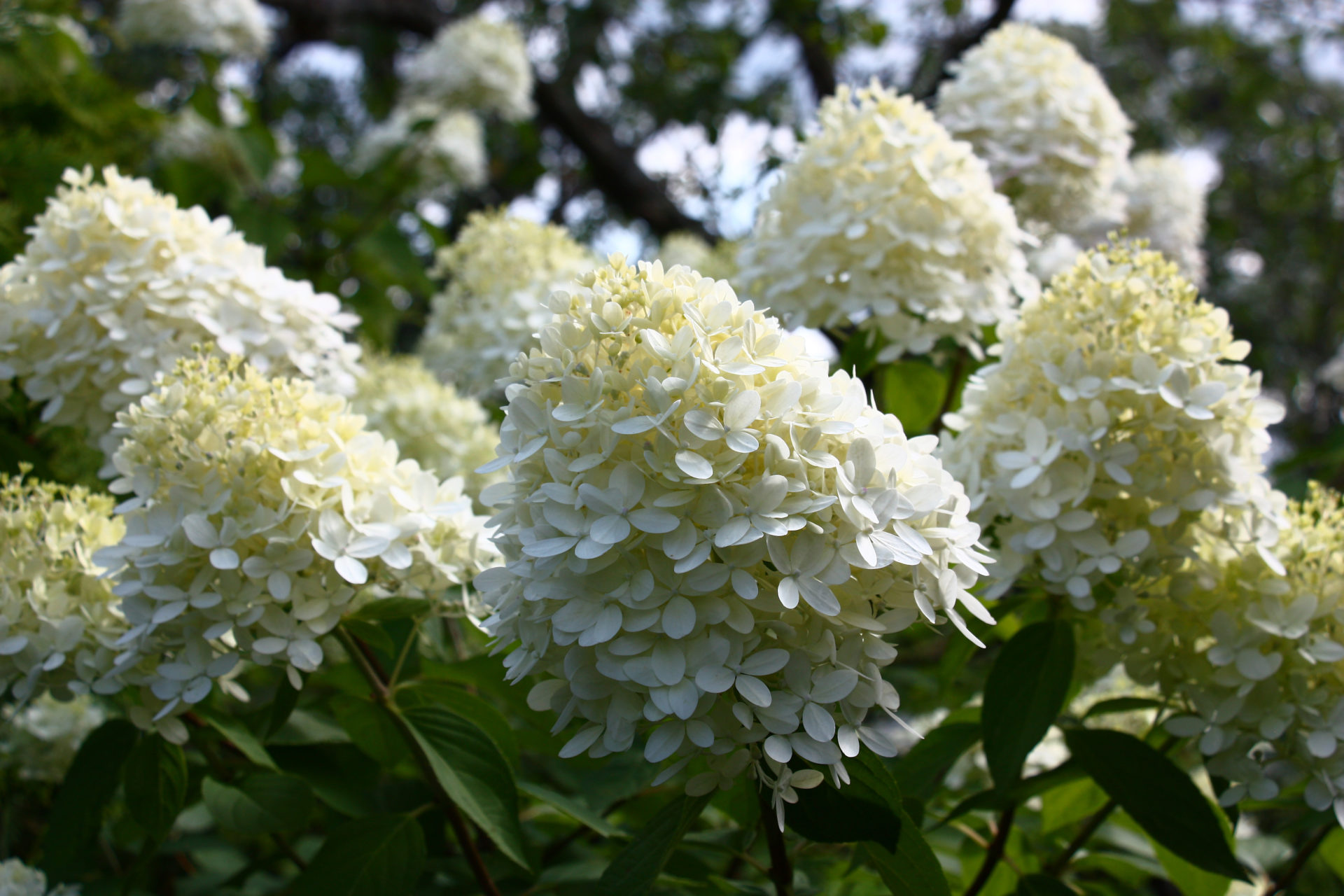
While we have all seen a certain amount of rain in recent days, many gardens in Massachusetts are still showing signs of stress, and if like me, you are likely to lose a few of your plants to the drought, maybe you are wondering what you might plant as a drought tolerant replacement. What follows is a selection of some of the drought tolerant trees and shrubs that can be found in our garden centers. Please note even plants classed as drought tolerant need supplemental water while getting established after planting. This is particularly important during warm summer months. Check out our plant watering guidelines for detailed information.
Smoke Bush (Cotinus coggygria)
Smoke bush makes an eye-catching accent shrub for sunny spots, with a number of varieties reaching as much as 10’ tall and wide. A summer-blooming plant, it gets its common name from the plumes of long-lasting, wispy flowers resembling pink smoke. Even without the flowers, it has attractive foliage, which depending on the variety comes in shades of green, chartreuse or purple. Come fall the leaves bring fiery tones to the landscape. ‘Royal Purple’ is a popular purple variety, ‘Velvet Cloak’ is another purple with particularly good fall color, while ‘Golden Spirit’ has that chartreuse foliage. And if these varieties are too big, Winecraft Black® and Winecraft Gold® both stay a neat, compact size, being 5’ tall and wide, and offer deep purple and golden yellow leaves respectively.
Panicle Hydrangea (Hydrangea paniculata)
A New England favorite due to its long-lasting flowers and undemanding nature, panicle hydrangea can be found in a variety of sizes and forms. From the compact forms of Little Lime® and Bobo®, through larger favorites such as Limelight, Quick Fire® and Vanilla Strawberry™ there is a panicle hydrangea to suit any sunny location. Varieties such as Limelight and Pinky Winky® are regularly available in tree-form adding to the versatility of this plant. The flowers can be left to provide winter interest or cut to be used as dried flowers. This type of hydrangea blooms on new growth, so pruning should be done in late winter or early spring when stems should be cut back by a third.
Spirea spp.
While the native meadowsweet, spirea latifolia, enjoys moist conditions, Japanese cultivars of this shrub offer both drought tolerance, and a wealth of pink and red flowers set against foliage, which can range from golden yellow to dark green. New growth can be tinged red, as in the cultivar Double Play® Candy Corn® and overall height varies from two to four feet, depending on the variety. Bridal Wreath Spirea (spirea x vanhouttei) grows taller at 7-8’ tall and produces clusters of white flowers spaced along arching branches, while Snowmound Boxwood Spirea (spirea nipponica ‘Snowmound’) offers the same type of flowers in a more modest 3-5’ tall and wide. This sun-loving shrub’s flowers are attractive to pollinators and the foliage is deer resistant.
Sweetfern (Comptonia peregrina)
This native plant has aromatic leaves that resemble those of ferns. It is a small, shrubby plant two to four feet tall, ideally suited for shadier conditions as it can be found as part of the understory in New England woodlands. Its flowers are small catkins, similar to those found on hazel, which appear before it leafs out. Given time, it can spread to form dense colonies.
Pine (Pinus spp.)
Pines are one of several evergreen trees that are tolerant of dry conditions. Whether our native Eastern White Pine (Pinus strobus) or introduced varieties such as Japanese White Pine, the glauca group of which is a winner of the Cary Award, Scots Pine and Mugo Pine there is a wealth of options for north-eastern landscapes. While the non-native pines are often found as slow-growing, ornamental specimens, rather than full-size examples, it should be noted that there are similar compact varieties of Eastern White Pine, which include ‘Soft Touch’ and ‘Blue Jay’ to name a couple.
Yew (Taxus spp.)
A traditional hedging plant, yew also offers a number of ornamental varieties as stand-alone specimens. Tall, columnar forms include Hick’s Yew (taxus x media ‘Hicksii’) and Viridis Yew (taxus x media ‘Viridis’), while low, spreading forms can be found in Emerald Spreader Japanese Yew (taxus cuspidata Emerald Spreader) and Dense Spreading Yew (taxus media densiformis). Although deer can be a problem for this plant, it does have the benefit of being adapted to a wide range of light conditions from full sun through to full shade.
Sumac (Rhus spp.)
There are a couple of types of native sumac that are used ornamentally. For ground cover, aromatic sumac makes a good option, particularly on difficult sites where the prevention of soil erosion is needed. The species reaches 3-5’ tall, is tolerant of poor soil, and can form dense thickets with time. The cultivar ‘Gro-Low’ is true to its name at 2-3’ tall, but can spread as much as 8’. Both have particularly colorful fall foliage in shades of red. The spring flowers, while not overly ornamental, are a nectar source for butterflies.
Tiger Eyes™ staghorn sumac (rhus typhina ‘Tiger Eyes™’) is a smaller and less rampant sport of the native staghorn sumac, and makes a small tree of around 6-8’ tall and wide. It has elegant golden, cut-leaf foliage, which turns a vibrant orange in fall, and then throughout winter adds interest with its fuzzy, red-brown bark.
Juniper (Juniperus spp.)
Juniper is another evergreen for sunny spots, and similar to pine and yew, can be found as upright pyramidal forms, or lower growing specimens with either a spreading or mounding habit. Depending on the cultivar, foliage can be green, blue-gray or golden yellow. Upright growing specimens can be used for screening, including our native Eastern red cedar (juniperus virginiana). Blue-gray, berry-like cones are produced on female plants, and these are a good winter food source for birds.
Sources:
https://ag.umass.edu/landscape/fact-sheets/drought-tolerant-plants-for-landscape
https://www.missouribotanicalgarden.org/PlantFinder/PlantFinderDetails.aspx?kempercode=f180
https://www.missouribotanicalgarden.org/PlantFinder/PlantFinderDetails.aspx?taxonid=279605
https://www.missouribotanicalgarden.org/PlantFinder/PlantFinderDetails.aspx?kempercode=c293









